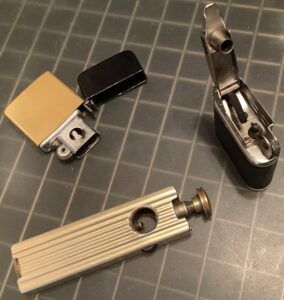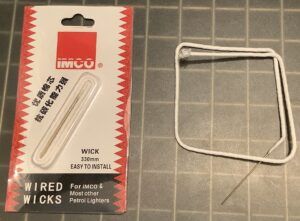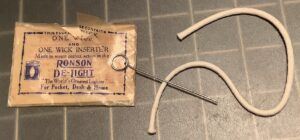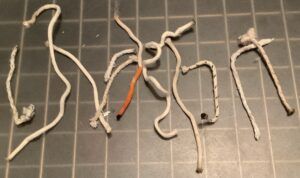(As an Amazon Associate and Ebay Partner, I earn from qualifying purchases.)
There aren’t a ton of options available when it comes to replacing the wick in your vintage cigarette lighter. That doesn’t mean you won’t have a decision to make nor does it preclude you feeling bloody and beaten, confused and forsaken by all the advice you can expose yourself to online. Here are just a few considerations I posit as useful to me as I have come to experience the world of vintage petrol lighters from the wrong end of history regarding convenience but the perfect time to salvage them from the heap.
What Would You Like Your Wick To Do Or How Would You Like It To Treat You?
Some folks simply need to click the file wheel and graze a flame with their cigarette. Easy, peazy put that lighter away. Pipe or cigar smokers, on the other hand, may require a more robust flame to ignite what they intend to combust. So, what kind of wick should I use on my vintage petrol lighter?
The type of flame you hope to achieve could play some part in deciding what

wick to install in your lighter. The ease of getting the wick into the lighter may influence your decision as well. Until recently, I had based my decision on ease of installation and ability to shape the flame. Now, thanks to useful discussions with YouTube viewers, I’ve also begun to consider if one type wick is more conducive to ignition than the others.
Whatever you decide, it amounts to a personal preference. You aren’t likely to ruin your lighter by installing the wrong wick and you can always go back and use a different style wick the next time. Just be patient! If the wick or wire get hung up, don’t force anything! Take your time. Be deliberate and you can always take a step back.
Copper Woven, Zippo Wicks
Zippo copper woven wicks are probably the most commonly available wicks on the market today. They can often be found at the checkout or camping

section of your local Wal-Mart, customer service desk of your grocery store or pharmacy and of course, your local smokeshop.
The copper woven through the wicks allows the user to shape the wick into position as they like, whereas shape of the Imco and Ronson wicks is dictated more by the length and just dealt with.

I use the copper woven wicks on pretty much all flip-top, insert type lighters even though many, like the Champ Austria lighters, had more limp type wicks originally.
I have a viewer on the YouTube channel, Giovanni Abazia, who said last week the copper woven through the wick helps ignition by affecting temperature at the wick. That kind of blew my mind. He said he uses Zippo wicks in all lighters, even Imco for that very reason.
One reason I don’t like the copper woven wicks for most lighters is they seem, if not thicker, then stiffer in the diameter. Using my wire lasso trick on a Zippo wick wouldn’t bring the lighter’s effective diameter down much because of the stiffness provided by the woven copper. They just seem a tougher squeeze into most lighters than a wire tied Imco or Ronson wick.
Imco Wire Lead Wicks
Imco wicks are good for lighters where you are feeding the

wick blindly but don’t have distance or other impediments to keep you from retrieving the wired end of the wick out the fuel hole in the base of the lighter. There are a number of potential hurdles one can encounter while rewicking a lighter. These include flint tubes, plunger spring seats, jet tubes and the like.
The Imco wicks available on Ebay today were manufactured in China and are much more tightly woven or contained out of the package than the Imco wicks that were being sold a few years ago. I don’t think the size is actually different, it’s just they are very stiffly woven and glued very tightly to the wire. I don’t really have a complaint or preference with the Imco wicks marked made in China, I just want to note there seems to me an obvious difference.
There have been a time or two including a Ronson Crown where the wire wasn’t even necessary because the wick was so stiff it just fed straight down the chimney! That being said, take caution to spread your wick at the top after trimming it for length. If your lighter is not packed very densely, you could lose the wick down the chimney.
Wicks Of Varying Diameters
While Zippo and Imco wicks will work in the vast majority of petrol lighters you encounter, there are lighters that were meant to accept wicks of slightly varying diameters from those. In certain lighters a perfect fit may not be necessary while in another the perfect fit might make all the difference in the way the lighter operates.
There is an Ebay seller based in the United Kingdom that offers wicks in at least three different diameters to suit your needs. While I have not purchased from this seller myself, I would have no problem doing so if ever I run into a lighter that requires a different diameter wick.
Old Stock Ronson Wicks With The Wire Inserter
Ronson wicks come with a wire inserter that to this day I have

yet to employ. Once or twice, maybe it was in a dream, I can’t really recall, I’ve looked at that piece of wire and for a fleeting moment I thought I could see how it might have originally been intended to have been used but alas, I don’t have the heart for failure when tying a wire to the end of it is so simple and works so well.
Our most viewed video on YouTube demonstrates how to tie a thin wire knot(kind of a two ended lasso) to the end of the wick and feed it into any petrol lighter. These old Ronson wicks work great for that blind method of rewicking your lighter.
Sometimes dusty and dirty, if you can find them with their glassine envelopes at least somewhat intact, they generally work and burn fairly well as long as there’s no obvious signs of contamination to the wick itself. They may appear somewhat sporadic at times but listings for old stock Ronson wicks can generally be found on Ebay and other online sites. Old Ronson Repair Kits contained wicks as well, so keep an eye out for those.
The Perfect Wick For The Job
There are supposedly wicks in some old lighters that contain asbestos. It

would seem to me prudent not to be inhaling those kinds of materials unnecessarily just to light your bowl. So I usually rewick any lighter that I intend to actual deploy for personal use.
However, I can’t tell you exactly what is in those old Ronson wicks and I use them all the time.
Many lighters claim to require wicks of which available stock was depleted long ago. Who’s to say what is the proper, if not best wick for that situation where the original had disintegrated and a replacement can’t be found? You do the best you can and move on. If it doesn’t work well, you’ll try another wick!
I would appreciate any information readers are able to contribute to this discussion either by email, text or the comments section below this article. Do you have access to any other old or new brand of wicks that I am ignorant of?
Please check out and subscribe to the DependableFlame YouTube channel, if you haven’t already. There’s a lot of exciting stuff going on over there including a new video every weekday morning and useful discussion about vintage petrol lighters with other collectors, viewers and lighter users from around the world.
You can always leave a comment on any page of this site, may scroll to the bottom.
Also follow DependableFlame.com and post photos for your lighter questions on our Facebook page!
Until next time.✌️
Your videos are very informative…I just started collecting lucite table lighters and gifting my girlfriend with them. The lighter assembly on most of them separate from the acrylic…can these be repaired? Do they make a modern day replacement? A video would be great. A company called Astrolite made a bunch of these…
Hey Steve, check your email! I have some inserts ready to send you!
Thank you for your information on a rather obscure topic. I have recently taken up pipe smoking after a 40 years lapse. At the same time I acquired two nimrod lighters with the pipe circle top on a flip top base and while one initially lit first wheel turn it now takes many multiple ties to light. I have replaced flint, new fuel and reversed wick(which seemed intact) without success.
Any suggestions?
Richard
Thank you for the question, hopefully I can be some help. I am wondering if this occurs after fueling the lighter as it sounds like it may be suffering from vapor lock caused by the ignition area having too much fuel and not enough oxygen. Have you tried to let the vapors disperse and then try ignition? It is also possible the wick has become contaminated with something that is not conducive to producing a usable flame and may need to be replaced.
I have produce a wick which i consider to be one of the best available.
Its made to the original Ronson spec in the UK
100 finest cotton.
Item 264684179469
On ebay.
I also have also made Thorens wicks exactly as the 1910 wick with the blue or red fleck in.
Item 265059708999
Please let me know what you think if you try them.
Keep collecting !!!
Ps i have also made the ronson petrol filler seals as well.
I will definitely check out your products David!✌️
I have a tiny pistol lighter marked with only made in occupied Japan. The lighter is 2 inches long by 1.5 inches tall. I need a wick for it. What is the diameter of the Imco wired wicks? The wick hole on my lighter is around .080 of an inch. Probably a little smaller. It looks to be about half the diameter of the flint hole. Thanks.
I’m not positive about the diameter for the Imco wick but would bet a good deal of change that it’ll fit in your lighter.✌️
Great article! I have two Rowenta Snip lighters and need a suitable wick for both. But before I must figure out how to loosen the screw that secures it in place. The original manual recommends to use tweezers. I couldn’t find (yet) the best tool for the job though. Any ideas on the best sort of wick for these small lighters from the 1960s? Thanks in advance.
Hey, thank you I really appreciate the question! I don’t have experience with that specific lighter but from the looks of the petrol Snips I saw listed on Ebay it is a similar setup to the Elgin American fuel tank. I made a video for changing the wick in the Elgin American a couple yrs ago that should help. Can your explain what you mean by the “screw that secures it in place”?